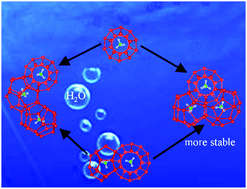Cage fusion from bi-cages to tri-cages during nucleation of methane hydrate: a DFT-D simulation†
Abstract
Water-cage clusters encapsulating guest molecules are the basic components of hydrate crystal structures. Herein, we investigated the fusion process from bi-cages to tri-cages to probe the nucleation mechanism at the initial stage of CH4 hydrate formation by employing dispersion-corrected density functional theory. We found that tri-cages possess high stability by sharing three, rather than two, polygonal faces. In addition, any mono-cage combined with a nonstandard 4151062 cage could achieve considerable stability regardless of which face is shared; this finding illustrates that 4151062 cages are more likely to appear at the early stages of CH4 hydrate nucleation than other nonstandard cages. We then simulated the Raman spectra of CH4 molecules in water-cage to characterize the spectral characteristics of the CH4 hydrate. The C–H symmetric stretching frequency of encapsulated CH4 molecules red-shifted with increasing mono-cage size, which follows the prediction of the “loose cage–tight cage” model. The symmetric stretching vibrational frequencies of trapped CH4 molecules in the tri-cage revealed a clear red-shift compared with those in the component mono- and bi-cages. The cage fusion process and spectroscopic properties described in this work are expected to provide new atomistic insights into CH4 hydrates at the initial nucleation stage.



 Please wait while we load your content...
Please wait while we load your content...